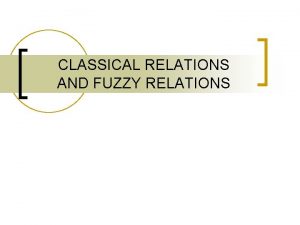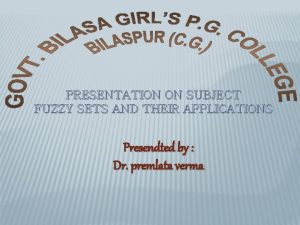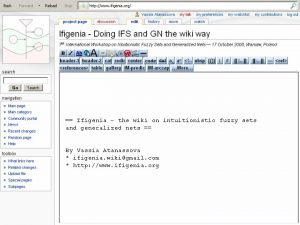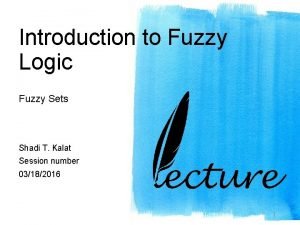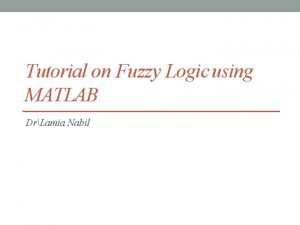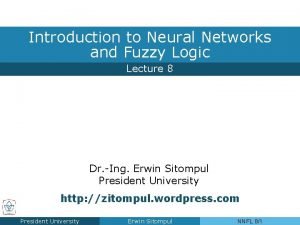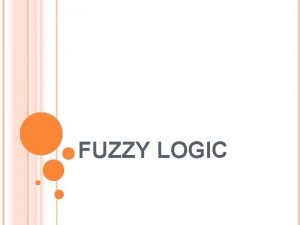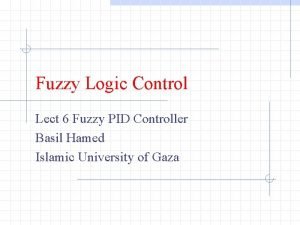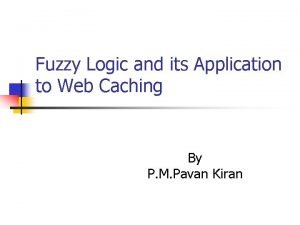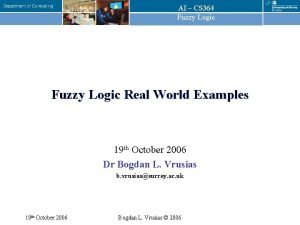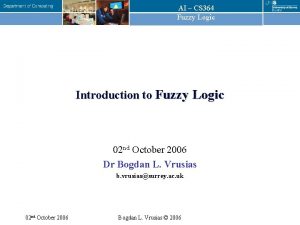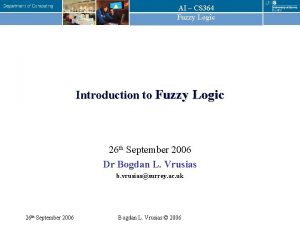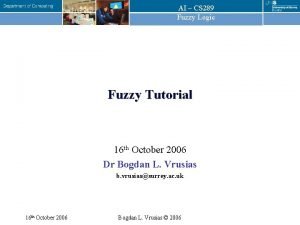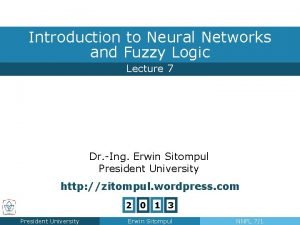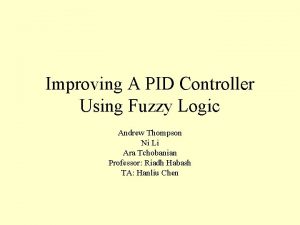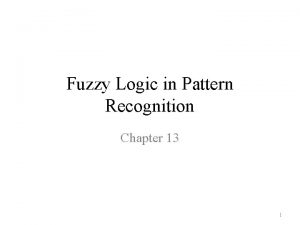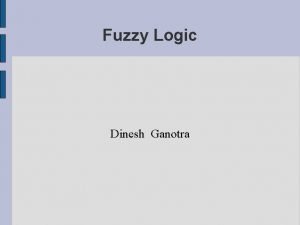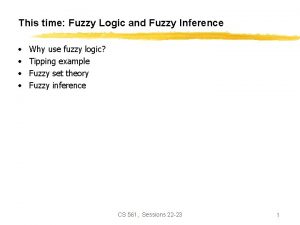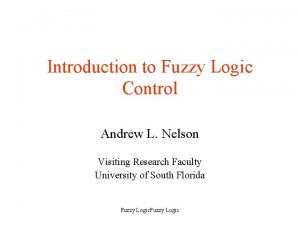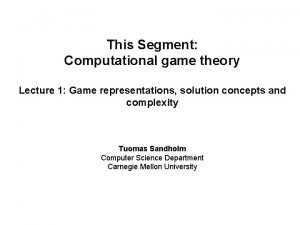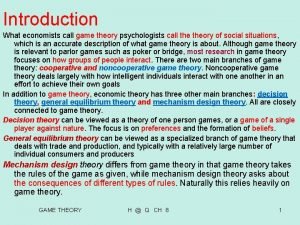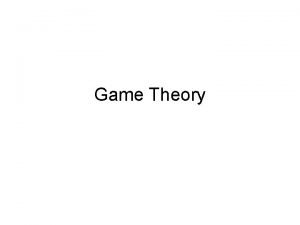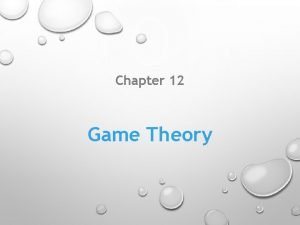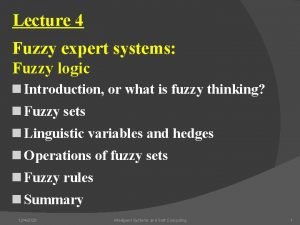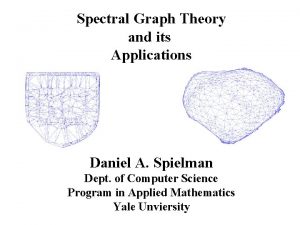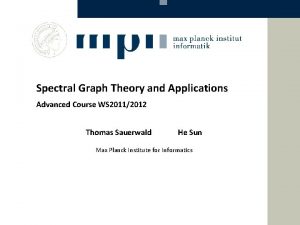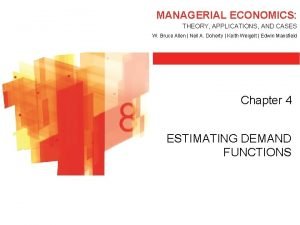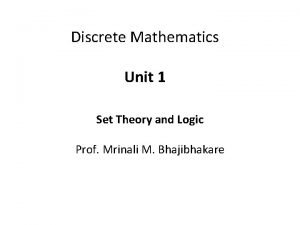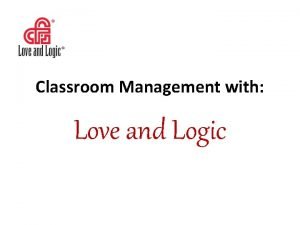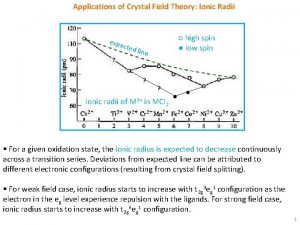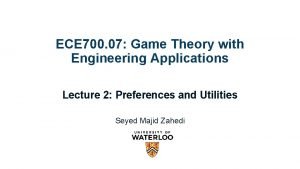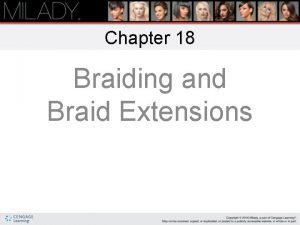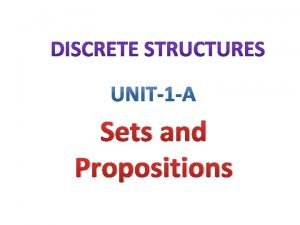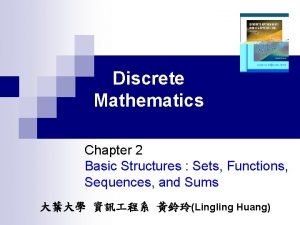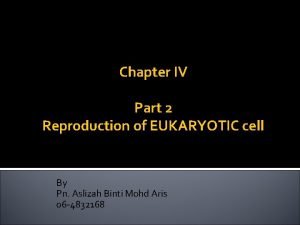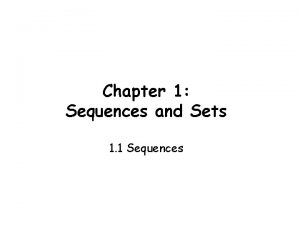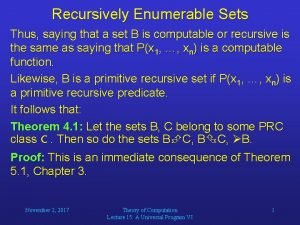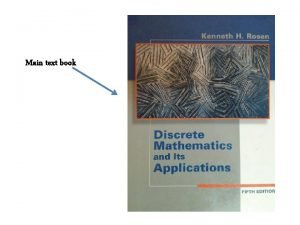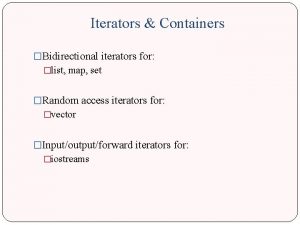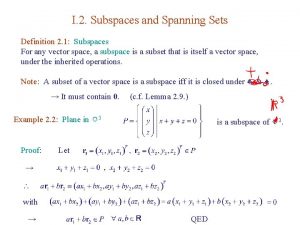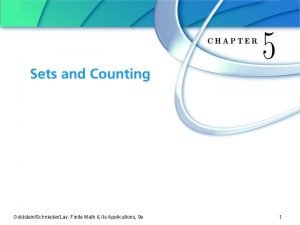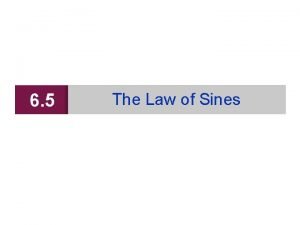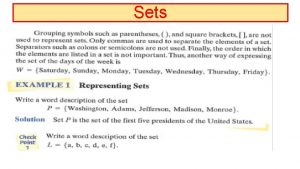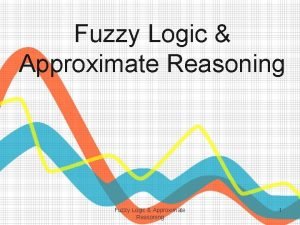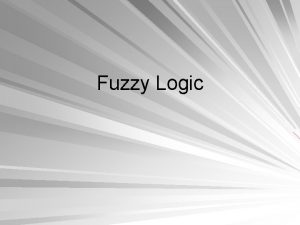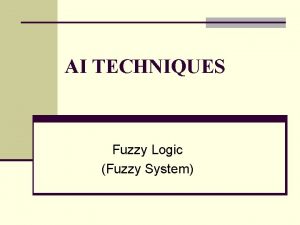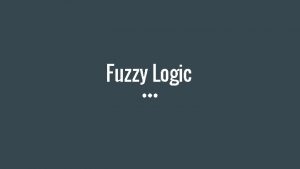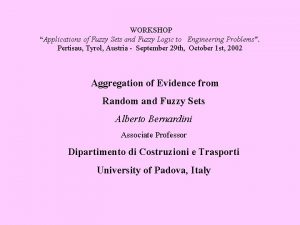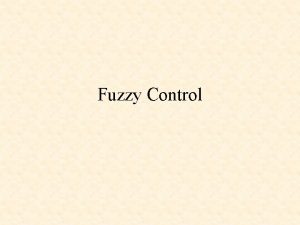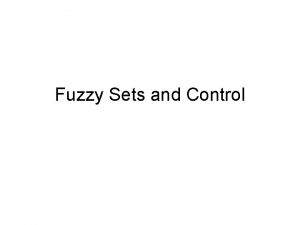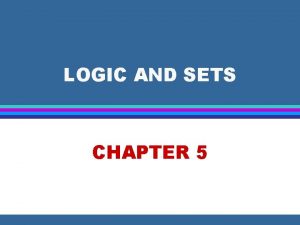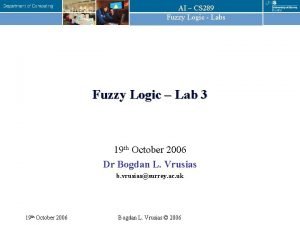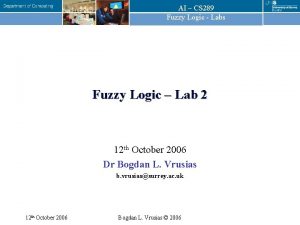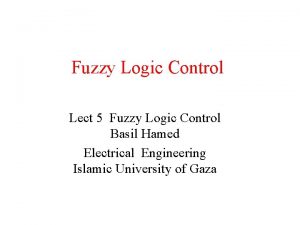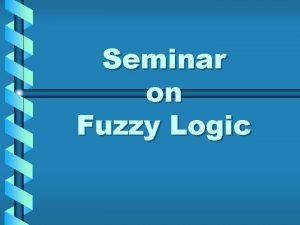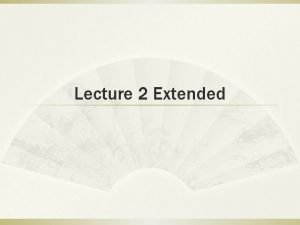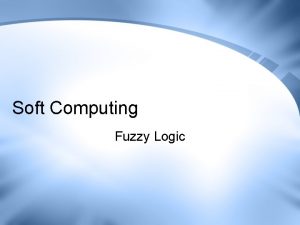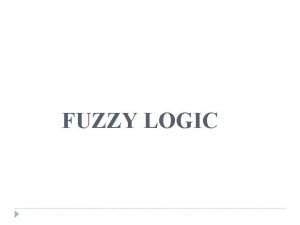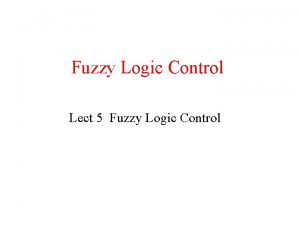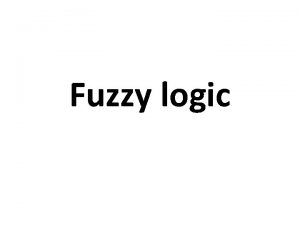Fuzzy Sets and Fuzzy Logic Theory and Applications






























































- Slides: 62

Fuzzy Sets and Fuzzy Logic Theory and Applications G. J. Klir, B. Yuan 1

Part one: theory 2

Part one: Theory Chapter 1 From Crisp Sets to Fuzzy Sets 3

1. 1 Introduction l Uncertainty ¡ Probability theory is capable of representing only one of several distinct types of uncertainty. ¡ When A is a fuzzy set and x is a relevant object, the proposition “x is a member of A” is not necessarily either true or false. It may be true only to some degree, the degree to which x is actually a member of A. ¡ For example: the weather today l Sunny: If we define any cloud cover of 25% or less is sunny. l This means that a cloud cover of 26% is not sunny? l “Vagueness(含糊)” should be introduced. 4

1. 1 Introduction l The crisp set v. s. the fuzzy set ¡ The crisp set is defined in such a way as to dichotomize(二分) the individuals in some given universe of discourse into two groups: members and nonmembers. l However, many classification concepts do not exhibit this characteristic. l For example, the set of tall people, expensive cars, or sunny days. ¡ A fuzzy set can be defined mathematically by assigning to each possible individual in the universe of discourse (論域) a value representing its grade of membership in the fuzzy set. l For example: a fuzzy set representing our concept of sunny might assign a degree of membership of 1 to a cloud cover of 0%, 0. 8 to a cloud cover of 20%, 0. 4 to a cloud cover of 30%, and 0 to a cloud cover of 75%. 5

1. 2 Crisp sets: an overview l The theory of crisp set ¡ The following general symbols are employed throughout the text: 6

1. 2 Crisp sets: an overview l Three basic methods to define sets: ¡ The list method: a set is defined by naming all its members. ¡ The rule method: a set is defined by a property satisfied by its members. where ‘|’ denotes the phrase “such that” P(x): a proposition of the form “x has the property P ” ¡ A set is defined by a characteristic function. the characteristic function 7

1. 2 Crisp sets: an overview l A family of sets: a set whose elements are sets ¡ It can be defined in the form: where i and I are called the set index and the index set, respectively. ¡ The family of sets is also called an indexed set. ¡ For example: A l l l A is a subset of B: A, B are equal sets: A and B are not equal: A is proper subset of B: A is included in B: 8

1. 2 Crisp sets: an overview l The power set of A ( ): the family of all subsets of a given set A. ¡ The second order power set of A: ¡ The higher order power set of A: l The cardinality of A (|A|): the number of members of a finite set A. ¡ For example: l B – A: the relative complement of a set A with respect to set B ¡ If the set B is the universal set, then ¡ ¡ ¡ 9

1. 2 Crisp sets: an overview l The union of sets A and B: l The generalized union operation: for a family of sets, l The intersection of sets A and B: l The generalized intersection operation: for a family of sets, 10

1. 2 Crisp sets: an overview 11

1. 2 Crisp sets: an overview l The partial ordering of a power set: ¡ Elements of the power set of a universal set can be ordered by the set inclusion. l Disjoint: ¡ any two sets that have no common members http: //en. wikipedia. org/wiki/File: Hasse_diagram_of_powerset_of_3. svg 12

Partially ordered set 13 http: //en. wikipedia. org/wiki/File: Poset 6. jpg

1. 2 Crisp sets: an overview l A partition on A ( ): ¡ A family of pairwise disjoint nonempty subsets of a set A is called a partition on A if the union of these subsets yields the original set A. ¡ Members of a partition are usually referred to as blocks of the partition. ¡ Each member of A belongs to one and only one block of. 14

1. 2 Crisp sets: an overview 15

1. 2 Crisp sets: an overview 16

1. 2 Crisp sets: an overview l A set whose members can be labeled by the positive integers is called a countable set. l If such labeling is not possible, the set is called uncountable. ¡ For example, { a | a is a real number, 0 < a < 1} is uncountable. l Every uncountable set is infinite. l Countable sets are classified into finite and countable infinite. 17

1. 2 Crisp sets: an overview l : the n-dimensional Euclidean vector space for some l A set A in is convex iff, for every pair of points r and s in A, all points located on the straight-line segment connecting r and s are also in A. l For example, A=[0, 2]U[3, 5] is not convex. ¡ Let r = 1, s = 4, and =0. 4; then 18

1. 2 Crisp sets: an overview 19

1. 2 Crisp sets: an overview l Let R denote a set of real number. ¡ If there is a real number r such that for every , then r is called an upper bound of R, and R is bounded above by r. ¡ If there is a real number s such that for every , then s is called an lower bound of R, and R is bounded below by s. l For any set of real numbers R that is bounded above, a real number r is called the supremum (上確界) of R (write r = sup R) iff (a) r is an upper bound of R; (b) no number less than r is an upper bound of R. l For any set of real numbers R that is bounded below, a real number s is called the infimum of R (write s = inf R) iff (a) s is an lower bound of R; (b) no number greater than s is an lower bound of R. 20

1. 3 Fuzzy sets: basic types l A membership function: ¡ A characteristic function: the values assigned to the elements of the universal set fall within a specified range and indicate the membership grade of these elements in the set. ¡ Larger values denote higher degrees of set membership. l A set defined by membership functions is a fuzzy set. l The most commonly used range of values of membership functions is the unit interval [0, 1]. l We think the universal set X is always a crisp set. l Notation: ¡ The membership function of a fuzzy set A is denoted by : ¡ In the other one, the function is denoted by A and has the same form ¡ In this text, we use the second notation. 21

1. 3 Fuzzy sets: basic types 22

1. 3 Fuzzy sets: basic types l The four fuzzy sets are similar in the sense that the following properties are possessed by each l Each function in Fig. 1. 2 is a member of a parameterized family of functions. Can you find the values of parameters p 1, p 2, p 3, and p 4? 23

1. 3 Fuzzy sets: basic types l An example: ¡ Define the seven levels of education: Highly educated (0. 8) Very highly educated (0. 5) 24

1. 3 Fuzzy sets: basic types l Several fuzzy sets representing linguistic (語言的) concepts such as low, medium, high, and so one are often employed to define states of a variable. Such a variable is usually called a fuzzy variable. l For example: 25

1. 3 Fuzzy sets: basic types l Now, we introduced only one type of fuzzy set. Given a relevant universal set X, any arbitrary fuzzy set of this type is defined by a function of the form This kind of fuzzy sets is called ordinary fuzzy sets. l Interval-valued fuzzy sets: ¡ The membership functions of ordinary fuzzy sets are often overly precise. ¡ We may be able to identify appropriate membership functions only approximately. ¡ Interval-valued fuzzy sets: a fuzzy set whose membership functions does not assign to each element of the universal set one real number, but a closed interval of real numbers between the identified lower and upper bounds. 26 Power set

1. 3 Fuzzy sets: basic types 27

1. 3 Fuzzy sets: basic types l Fuzzy sets of type 2: ¡ : the set of all ordinary fuzzy sets that can be defined with the universal set [0, 1]. ¡ is also called a fuzzy power set of [0, 1]. 28

1. 3 Fuzzy sets: basic types l Discussions: ¡ The primary disadvantage of interval-value fuzzy sets, compared with ordinary fuzzy sets, is computationally more demanding. ¡ The computational demands for dealing with fuzzy sets of type 2 are even greater then those for dealing with interval-valued fuzzy sets. ¡ This is the primary reason why the fuzzy sets of type 2 have almost never been utilized in any applications. 29

1. 3 Fuzzy sets: basic types l L-fuzzy set: ¡ The membership grades is represented by symbols of an arbitrary set L that is at least partially ordered. ¡ L-fuzzy sets are very general. They capture all the other types introduced thus far as special cases. 30

1. 3 Fuzzy sets: basic types l Level 2 fuzzy sets: ¡ : the fuzzy power set of X. ¡ Level 2 fuzzy sets allow us to deal with situations in which elements of the universal set cannot be specified precisely, but only approximately. ¡ For example: l Assuming that the proposition “x is close to r” is represented by an ordinary fuzzy set B, the membership grade of a value of x that is known to be close to r in the level 2 fuzzy sets A is given by A(B). 31

1. 3 Fuzzy sets: basic types l Fuzzy sets of type 2 and level 2: ¡ : the fuzzy power set of X. l Other combinations are also possible. 32

1. 3 Fuzzy sets: basic types l Discussions: ¡ These generalized types of fuzzy sets have not as yet played a significant role in applications of fuzzy set theory. ¡ Two reasons to introduce the generalized fuzzy sets in this section: l The reader can understand that fuzzy set theory does not stand or fall with ordinary fuzzy sets. l The practical significance of some of the generalized types will increase. 33

1. 4 Fuzzy sets: basic concepts l Consider three fuzzy sets that represent the concepts of a young, middle-aged, and old person. The membership functions are defined on the interval [0, 80] as follows: young middle-aged old 34

1. 4 Fuzzy sets: basic concepts 35

1. 4 Fuzzy sets: basic concepts l -cut and strong -cut ¡ Given a fuzzy set A defined on X and any number the -cut and strong -cut are the crisp sets: ¡ The -cut of a fuzzy set A is the crisp set that contains all the elements of the universal set X whose membership grades in A are greater than or equal to the specified value of. ¡ The strong -cut of a fuzzy set A is the crisp set that contains all the elements of the universal set X whose membership grades in A are only greater than the specified value of. 36

1. 4 Fuzzy sets: basic concepts l For example: 37

1. 4 Fuzzy sets: basic concepts l A level set of A: ¡ The set of all levels given fuzzy set A. that represent distinct -cuts of a ¡ For example: 38

1. 4 Fuzzy sets: basic concepts l The properties of -cut and strong ¡ For any fuzzy set A and pair such that , we have -cut of distinct values ¡ All -cuts and all strong -cuts of any fuzzy set form two distinct families of nested crisp sets. 39

1. 4 Fuzzy sets: basic concepts l For example: consider the discrete approximation D 2 of fuzzy set A 2 40

1. 4 Fuzzy sets: basic concepts l The support of a fuzzy set A: ¡ The support of a fuzzy set A within a universal set X is the crisp set that contains all the elements of X that have nonzero membership grades in A. ¡ The support of A is exactly the same as the strong -cut of A for. ¡S(A) or supp(A) = . l The core of A: ¡ The 1 -cut of A ( 1 A) is often called the core of A. 41

1. 4 Fuzzy sets: basic concepts l The height of a fuzzy set A: ¡ The height of a fuzzy set A is the largest membership grade obtained by any element in that set. ¡ A fuzzy set A is called normal when h(A) = 1. ¡ It is called subnormal when h(A) <1. ¡ The height of A may also be viewed as the supremum of for which. 42

1. 4 Fuzzy sets: basic concepts l The convexity: ¡ -cuts of a convex fuzzy set should be convex for all. ¡ For example: l Fig. 1. 9 illustrates a subnormal convex fuzzy set. l Fig. 1. 10 illustrates a normal fuzzy set that is not convex. l Fig. 1. 11 illustrates a normal fuzzy set defined on by all its -cuts for 43

1. 4 Fuzzy sets: basic concepts Fig. 1. 10 Normal fuzzy set that is not convex. 44

1. 4 Fuzzy sets: basic concepts 45

1. 4 Fuzzy sets: basic concepts l Discussions: ¡ The definition of convexity for fuzzy sets does not mean that the membership function of a convex fuzzy set is a convex function. ¡ In fact, membership functions of convex fuzzy sets are concave functions, not convex ones. 46

Convex function l In mathematics, a real-valued function f defined on an interval is called convex, if for any two points x and y in its domain C and any t in [0, 1], we have l In other words, a function is convex if and only if its epigraph (the set of points lying on or above the graph) is a convex set. http: //en. wikipedia. org/wiki/Convex_function 47

Concave function l In mathematics, a concave function is the negative of a convex function. l Formally, a real-valued function f defined on an interval is called concave, if for any two points x and y in its domain C and any t in [0, 1], we have http: //en. wikipedia. org/wiki/Concave_function 48

1. 4 Fuzzy sets: basic concepts 49

1. 4 Fuzzy sets: basic concepts l Cutworthy property: ¡ Any property generalized from classical set theory into the domain of fuzzy set theory that is preserved in all -cuts for. ¡ Convexity of fuzzy sets is an example of a cutworthy property. l Strong cutworthy property ¡ Any property generalized from classical set theory into the domain of fuzzy set theory that is preserved in all strong -cuts for. 50

1. 4 Fuzzy sets: basic concepts l The standard complement of fuzzy set A with respect to the universal set X is defined for all by the equation ¡ Elements of X for which are called equilibrium points of A. ¡ For example, the equilibrium points of A 2 in Fig. 1. 7 are 27. 5 and 52. 5. 51

1. 4 Fuzzy sets: basic concepts l Given two fuzzy sets, A and B, their standard intersection and union are defined for all by the equations where min and max denote the minimum operator and the maximum operator, respectively. 52

1. 4 Fuzzy sets: basic concepts l Another example: ¡ A 1, A 2, A 3 are normal. ¡ B and C are subnormal. ¡ B and C are convex. ¡ are not convex. Normality and convexity may be lost when we operate on fuzzy sets by the standard operations of intersection and complement. 53

1. 4 Fuzzy sets: basic concepts l Discussions: ¡ Normality and convexity may be lost when we operate on fuzzy sets by the standard operations of intersection and complement. ¡ The fuzzy intersection and fuzzy union will satisfies all the properties of the Boolean lattice listed in Table 1. 1 except the low of contradiction and the low of excluded middle. 54

1. 4 Fuzzy sets: basic concepts l The law of contradiction (矛盾律) l To verify that the law of contradiction is violated for fuzzy sets, we need only to show that is violated for at least one . ¡ This is easy since the equation is obviously violated for any value , and is satisfied only for 55

1. 4 Fuzzy sets: basic concepts l To verify the law of absorption (吸收律), ¡ This requires showing that is satisfied for all. ¡ Consider two cases: (1) (2) 56

1. 4 Fuzzy sets: basic concepts l Given two fuzzy set we say that A is a subset of B and write for all iff . ¡ 57

1. 4 Fuzzy sets: basic concepts 58

1. 4 Fuzzy sets: basic concepts 59

1. 4 Fuzzy sets: basic concepts l Given a fuzzy set A defined on a finite universal set X let x 1, x 2, …, xn denote elements of the support 0+A of A and let ai denote the grade of membership of xi in A for all ¡ If the universal set is finite or countable: ¡ If X is an interval of real numbers: the integral sign indicates that all the pairs of x and A(x) in the interval X collectively form A. 60

1. 4 Fuzzy sets: basic concepts 61

1. 4 Fuzzy sets: basic concepts 62
 Image sets
Image sets Fuzzy cartesian product example
Fuzzy cartesian product example Decomposition theorem of fuzzy sets
Decomposition theorem of fuzzy sets Wiki
Wiki Intersection of fuzzy sets
Intersection of fuzzy sets Image sets
Image sets Neural networks and fuzzy logic
Neural networks and fuzzy logic Tipping problem fuzzy logic
Tipping problem fuzzy logic Contoh himpunan fuzzy dalam kehidupan sehari-hari
Contoh himpunan fuzzy dalam kehidupan sehari-hari Fuzzy logic lecture
Fuzzy logic lecture What is fuzzy
What is fuzzy Fuzzy logic controller
Fuzzy logic controller Fuzzy logic thermostat
Fuzzy logic thermostat Gaussian membership function
Gaussian membership function Fuzzy logic examples from real world
Fuzzy logic examples from real world What is linguistic variables in fuzzy logic
What is linguistic variables in fuzzy logic What is linguistic variables in fuzzy logic
What is linguistic variables in fuzzy logic Cs 289
Cs 289 Logic sitompul
Logic sitompul Crisp set vs fuzzy set
Crisp set vs fuzzy set Fuzzy logic
Fuzzy logic Fuzzy logic in pattern recognition
Fuzzy logic in pattern recognition Dinesh ganotra website
Dinesh ganotra website Fuzzy logic
Fuzzy logic Fuzzy logic
Fuzzy logic Applications of propositional logic in discrete mathematics
Applications of propositional logic in discrete mathematics First order logic vs propositional logic
First order logic vs propositional logic First order logic vs propositional logic
First order logic vs propositional logic Third order logic
Third order logic Combinational logic vs sequential logic
Combinational logic vs sequential logic Cryptarithmetic problem logic+logic=prolog
Cryptarithmetic problem logic+logic=prolog Software development plan
Software development plan Is it x y or y x
Is it x y or y x Combinational logic sequential logic 차이
Combinational logic sequential logic 차이 Combinational logic sequential logic
Combinational logic sequential logic Information sets in game theory
Information sets in game theory Information sets in game theory
Information sets in game theory Information sets in game theory
Information sets in game theory Information sets in game theory
Information sets in game theory Information sets in game theory
Information sets in game theory Fuzzy theory
Fuzzy theory Daniel spielman spectral graph theory
Daniel spielman spectral graph theory Spectral graph theory and its applications
Spectral graph theory and its applications Managerial economics: theory, applications, and cases
Managerial economics: theory, applications, and cases Discrete mathematics
Discrete mathematics How i run my love and logic classroom
How i run my love and logic classroom Application of crystal field theory
Application of crystal field theory Clemson canvs
Clemson canvs Chapter 18 braiding and braid extensions
Chapter 18 braiding and braid extensions Sets and propositions in discrete mathematics
Sets and propositions in discrete mathematics Onto function
Onto function Chromosome sets (=n) in mitosis and meiosis
Chromosome sets (=n) in mitosis and meiosis Anaphase meaning
Anaphase meaning Sequences and sets
Sequences and sets Recursive and recursively enumerable sets
Recursive and recursively enumerable sets Subset text
Subset text Sets and maps java
Sets and maps java Maps and sets support bidirectional iterators.
Maps and sets support bidirectional iterators. Minimum spanning set
Minimum spanning set Unordered subsets
Unordered subsets A pilot sets out from an airport and heads in the direction
A pilot sets out from an airport and heads in the direction It is collection of well defined objects
It is collection of well defined objects Shape with 2 sets of parallel sides
Shape with 2 sets of parallel sides

